| Topic: DRAGONS UNICORNS MERMAIDS PEGASUS OTHER MYTHIC ANIMALS | |
|---|---|
|
Edited by
tazzops
on
Wed 08/17/11 05:45 AM
|
|
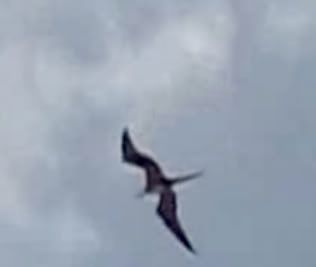
In the Age of Dinosaurs there existed flying reptiles called Pterosaurs. The fossil record suggests that they appeared in the Jurassic and lived into the Cretaceous, about 65 million years ago. Nearly all the fossils found have been in marine deposits, which means they probably were fish eaters and spent most of their time over coastal waters. These flying reptiles apparently managed to fly with no feathers, their main aerodynamic feature being wings of membrane supported by an enormously elongated fourth finger. They had hollow limb bones and a large keeled breastbone for attachment of strong wing muscles, needed for true flight and not just gliding. The large expenditure of energy required to remain in flight for long periods of time, and the resultant loss of heat caused by the surface of their wings exposed to moving air, means that they must have had some method of regulating body heat, although it is doubtful they were truly warm-blooded as mammals are. Although popular media has usually described pterosaurs as huge menacing creatures, most of the pterosaurs were much smaller, from the size of a sparrow to the size of an eagle. There have been some very large species discovered, however: the pteranodon with a wingspan of 27 ft. and the colossal quetzalcoatlus, with a wingspan of 50 ft. (and possibly up to 60 ft.). Some pterosaurs actually had fur, although they were not related to mammals. It would seem impossible that these creatures could have survived to the present day. After all, if they existed surely people would see them flying about as they hunted for food. How could a flying population of reptiles remain hidden? There are reports that people have been seeing flying creatures that match the description of pterosaurs for a long time. People have even been, reportedly, killed by them. Depiction of a native sighting, by Bill Rebsamen In 1923 a traveler by the name of Frank H. Melland worked for a time in Zambia. He gathered native reports of ferocious flying reptiles. The natives called this creature kongamato ("overwhelmer of boats"), which was said to have lived in the Jiundu swamps in the Mwinilunga District in western Zambia, near the border of Congo and Angola. It was described as having no feathers at all, smooth skin, a wingspan between 4 ft. and 7 ft., and possessing a beak full of teeth. They were usually described as black or red. It had a reputation for capsizing canoes and causing death to anyone who merely looked at it. When showed drawings of pterosaurs "... every native present immediately and unhesitatingly picked it out and identified it as a kongamato. Among the natives who did so was a headman from the Jiundu country, where the kongamato is supposed to be active, and who is a rather wild and quite unsophisticated native." In 1925, a distinguished English newspaper correspondent, G. Ward Price, was with the future Duke of Windsor on an official visit to Rhodesia. He reported a story that a civil servant told them of the wounding of a man who entered a feared swamp in Rhodesia known to be an abode of demons. The brave native entered the swamp, determined to explore it in spite of the dangers. When he returned he was on the verge of death. He had a great wound in his chest. He recounted how a strange huge bird with a long beak attacked him. When the civil servant showed the man a picture of a pterosaur from a book of prehistoric animals, the man screamed in terror and fled from the servant's home. In 1942 Colonel C. R. S. Pitman reported stories the natives had told him of a large bat/bird type creature that lived in Northern Rhodesia (now Zambia) in a dense swampy region--supposedly to look upon it was death. Tracks of the creatures were seen, with evidence of a large tail dragging the ground. These reports were not limited to Zambia, but also came from other locations in Africa such as Mount Kilimanjaro and Mount Kenya. Skeptics suggest that these fantastic sounding tales derived from the fanciful imaginations of natives who were hired to work at archeological digs where fossilized pterosaurs were uncovered in Tendagaru, Tanzania, in the years prior to World War I. These digs, however, took place over 900 miles from Zambia. Why did no reports of living pterosaurs come from Tanzania, where these imaginative natives lived? Perhaps the most striking report of living pterosaurs comes not from natives, but from white explorers in the employment of the British Museum. In 1932-3 the Percy Sladen Expedition went to West Africa. In charge of the team was Ivan T. Sanderson, a well-known zoologist and writer. While in the Assumbo Mountains in the Cameroons, they made camp in a wooded valley near a steep banked river. They were out hunting near the river when Sanderson shot a large fruit-eating bat. It fell in the water, and as Sanderson was carefully making his way in the fast moving current, he lost his balance and fell. He regained his balance when his companion suddenly shouted "Look out!" Depiction of the attack on Ivan Sanderson, by Chelsea Sams "And I looked. Then I let out a shout also and instantly bobbed down under the water, because, coming straight at me only a few feet above the water was a black thing the size of an eagle. I had only a glimpse of its face, yet that was quite sufficient, for its lower jaw hung open and bore a semicircle of pointed white teeth set about their own width apart from each other. When I emerged, it was gone. George was facing the other way blazing off his second barrel. I arrived dripping on my rock and we looked at each other. "Will it come back?" we chorused. And just before it became too dark to see, it came again, hurtling back down the river, its teeth chattering, the air "shss-shssing" as it was cleft by the great, black, dracula-like wings. We were both off-guard, my gun was unloaded, and the brute made straight for George. He ducked. The animal soared over him and was at once swallowed up in the night." Sanderson and George returned to camp where they asked the natives about the creature. Sanderson asked them, spreading his arms, what kind of bat is this large and is all black? "Olitiau!" was the response. They asked Sanderson where they had seen this creature. Sanderson pointed back at the river. The natives fled in terror in the opposite direction, taking only their guns and leaving their valuables behind. While it may be suggested that the creature that attacked Sanderson and George was merely the mate of the bat they had shot, it is somewhat dubious. Fruit bats are not known for attacking humans, and Sanderson, a highly knowledgeable and internationally respected zoologist, clearly indicated that he did not recognize the creature. Fruit bats are a brownish or yellowish color. Sanderson described the creature as all black. He, however, did describe it as a bat - and pterosaurs are bat-like. In 1956 in Zambia along the Luapula river, engineer J.P.F. Brown was driving back to Salisbury from a visit to Kasenga in Zaire. He stopped at a location called Fort Rosebery, just to the west of Lake Bangweulu, for a break. It was about 6:00 p.m. when he saw two creatures flying slowly and silently directly overhead. He, bewildered, observed that they looked prehistoric. He estimated a wingspan of about 3-3 1/2 feet, a long thin tail, and a narrow head, which he likened to an elongated snout of a dog. One of them opened its mouth in which he saw a large number of pointed teeth. He gave the beak to tail length at about 4 1/2 feet. After this report came out, a couple by the name of Mr. and Mrs. D. Gregor reported that they had seen 2 1/2 ft. long flying lizards in Southern Rhodesia, and a Dr. J. Blake-Thompson reported that natives of the Awemba tribe had told of huge flying creatures resembling rats that would attack humans. They lived in caves in cliffs near the source of the great Zambezi River. |
|
|
|
|
|
Edited by
tazzops
on
Wed 08/17/11 05:49 AM
|
|

N. A. Tombazi squinted as his porters yelled frantically, pointing downward in a frenzy. The glare of the sun against the ever-present snow blinded him for a second before he finally homed in on the source of the commotion, which was "…about three hundred yards away down the valley to the east of our camp." Tombazi would later recall this encounter in his Account of a Photographic Expedition to the Southern Glaciers of Kangchenjunga in the Sikkim Himalaya. The source of the commotion was a humanoid figure, wandering about in an upright fashion, pausing to tug on dwarf rhododendron bushes as it passed. The creature's dark figure cast it with extreme contrast to the white snow, and it was easily distinguishable. It wore no clothes, and any more observations were cut short as the beast moved into "some thick shrub" and disappeared. "...a couple of hours later, during the descent, I purposely made a detour so as to pass the place where the 'man' or 'beast' had been seen. I examined the footprints, which were clearly visible on the surface of the snow. They were similar in shape to those of a man, but only six to seven inches (15 to 17 cm) long by four inches (23 cm) wide at the broadest part of the foot. The marks of five distinct toes and the instep were perfectly clear, but the trace of the heel was indistinct, and the little that could be seen of it appeared to narrow down to a point. I counted fifteen such footprints at regular intervals ranging from one-and-a-half to two feet (30 to 45 cm). The prints were undoubtedly of a biped, the order of the spoor having no characteristics whatever of any imaginable quadruped. Dense rhododendron scrub prevented any further investigations as to the direction of the footprints..." Nonetheless, bad weather also gathered overhead, as shadows faded away, and so Tombazi decided to move on. Is this sighting, among others, an indication of a presence of an unknown bipedal creature living in a withdrawn manner in the Himalayas? This encounter took place in 1925, and not many people were aware of the rumours of the existence of such animals at the time. Since then, sightings, along with physical evidence, have amounted. Tombazi would later deny any belief in this creature, saying that he discounts the "...delicious fairy tales" of the natives, and believes what he saw was either a wandering recluse or a member of an isolated community of pious Buddhist puritans. However, the evidence remains, hinting at something that we have yet to understand. When back at Yoksun, Tombazi inquired if any man had gone in his direction during that particular period, and could have been mistaken for the mysterious silhouette in the snow. "...I gathered that no man had gone in the direction of Jongri since the beginning of the year." Abominable Snowman What about the 'Abominable Snowman' is so abominable? Perhaps it's the idea of something so close to us intellectually yet so different physically. Maybe it's the brute force suggested by relatively scarce tales. Quite possibly, it might be the idea that we, humanity, have areas to conquer that are ruled by beasts such as this. The idea of an animal of this form certainly makes us uneasy. Or maybe it's the chilling environment within which it resides: The Himalayas are as famous for their sheer size as they are for this beast that lurks amidst their peaks. The mountain chain has a length of about 2,400 kilometres and a width about 200 to 400 kilometres. Numerous peaks protrude into the sky at over 7,600 metres, one of them being the famed Mount Everest. These measurements are constantly being rendered obsolete as the mountains continue to rise every year as India impels into Nepal. When one considers the remoteness and size of this region of the earth, it does seem probable for a large creature, such as the reputed 'abominable snowman' to roam about the valleys, woods, crevices, and peaks of this behemoth mountain chain and elude humanity. To contemplate all the reported cases of this mystifying beast would be unfeasible due to numerous sightings and encounters that attribute to this beast's believability. One cannot hope to compile all this data, but one can come close, and shorten it down in the process. At one point, all these sightings start bearing a striking resemblance to one another. This adds to the credibility factor, but also makes for less interest, no one enjoys reading the same story repetitively. But as one reads on, it becomes impossible not to observe this data in one way or another and not to notice the sheer amount of data: physical and not. Our journey begins in Kathmandu. The Yeti has become a tourist attraction, although not to the extent of its North American cousin, Sasquatch. A person can sleep in the Yak & Yeti hotel or luxuriate in a warm meal at the Yeti bar, and get there by flying Yeti Airlines. But above 1,336 meters, commercialisation ends and the bare truth takes over: frigid wind, immeasurable snow, absolute isolation, and the possibility of a wild, hairy hominid watching you from around some frozen bend. The term 'abominable snowman' was a translation error, for there is nothing abominable about this fascinating creature. This name, implying at some vulgar monster, can be traced back to Henry Newman of the Calcutta Statesman. In one of his columns, he had made an attempt at translating metoh kangmi, and did a poor job at it, spelling it metch kangmi. His translation was 'abominable or filthy man of the snow'. People are fascinated by the mysterious, and further more by the dangers and 'filth', so the name became immensely popular. Indian scholar Sri swami Pranavananda wrote that metoh kangmi, was in fact a conjunction of different names for the red bear, mi-te meaning man-bear and kang-mi meaning snowman. The Sherpas, quite possibly the trustworthiest sources when it comes to this beast, call the snowman 'yeh-teh', thus the Yeti, which has spread almost to the extent of the abominable snowman. The reason the latter term is preferred is probably because of its flexibility, while the Yeti refers to a specific creature in a specific place in the world. Whether you look at sightings of similar creatures in North America, Russia, China, Australia, or some other part of the world, encounters that display any type of 'abominable' act are scarce. The Yeti seems to avoid people more than people attempt to avoid it. Perhaps that's why it is so experienced at parrying mankind. Tracks photographed by Eric Shipton in 1951 Displayed under Fair Use Comparison of one of the tracks with an ice-axe Displayed under Fair Use Footprints in the Snow N. A. Tombazi squinted as his porters yelled frantically, pointing downward in a frenzy. The glare of the sun against the ever-present snow blinded him for a second before he finally homed in on the source of the commotion, which was "…about three hundred yards away down the valley to the east of our camp." Tombazi would later recall this encounter in his Account of a Photographic Expedition to the Southern Glaciers of Kangchenjunga in the Sikkim Himalaya. The source of the commotion was a humanoid figure, wandering about in an upright fashion, pausing to tug on dwarf rhododendron bushes as it passed. The creature's dark figure cast it with extreme contrast to the white snow, and it was easily distinguishable. It wore no clothes, and any more observations were cut short as the beast moved into "some thick shrub" and disappeared. "…a couple of hours later, during the descent, I purposely made a detour so as to pass the place where the 'man' or 'beast' had been seen. I examined the footprints, which were clearly visible on the surface of the snow. They were similar in shape to those of a man, but only six to seven inches (15 to 17 cm) long by four inches (23 cm) wide at the broadest part of the foot. The marks of five distinct toes and the instep were perfectly clear, but the trace of the heel was indistinct, and the little that could be seen of it appeared to narrow down to a point. I counted fifteen such footprints at regular intervals ranging from one-and-a-half to two feet (30 to 45 cm). The prints were undoubtedly of a biped, the order of the spoor having no characteristics whatever of any imaginable quadruped. Dense rhododendron scrub prevented any further investigations as to the direction of the footprints…" Regardless of these peculiarities, bad weather gathered overhead and shadows faded away, so Tombazi decided to move on. Is this sighting, among others, an indication of a presence of an unknown bipedal creature living in a withdrawn manner in the Himalayas? This encounter took place in 1925, and not many people were aware of the rumours of the existence of such animals at the time. Since then, sightings, along with physical evidence, have amounted. Tombazi would later deny any belief in this creature, saying that he discounts the "…delicious fairy tales" of the natives, and believes what he saw was either a wandering recluse or a member of an isolated community of pious Buddhist puritans, something in more abundance than some unknown beast. However, the evidence remains, hinting at something that we have yet to understand. When back at Yoksun, Tombazi inquired if any man had gone in his direction during that particular period, and could have been mistaken for the mysterious silhouette in the snow. "…I gathered that no man had gone in the direction of Jongri since the beginning of the year." Abominable Snowman What about the 'abominable snowman' is so abominable? Perhaps it's the idea of something so close to us intellectually yet so different physically. Maybe it's the brute force suggested by relatively scarce tales. Quite possibly, it might be the idea that we, humanity, have areas to conquer that are ruled by beasts such as this. The idea of an animal of this form certainly makes us uneasy. Or maybe it's the chilling environment within which it resides: The Himalayas are as famous for their sheer size as they are for this beast that lurks amidst their peaks. The mountain chain has a length of about 2,400 kilometres and a width about 200 to 400 kilometres. Numerous peaks protrude into the sky at over 7,600 metres, one of them being the famed Mount Everest. These measurements are constantly being rendered obsolete as the mountains continue to rise every year as India impels into Nepal. When one considers the remoteness and size of this region of the earth, it does seem conceivable for a large creature, such as the reputed 'abominable snowman' to roam about the valleys, woods, crevices, and peaks of this behemoth mountain chain and elude humanity. To contemplate all the reported cases of this mystifying beast would be unfeasible due to numerous sightings and encounters that attribute to this beast's believability. One cannot hope to compile all this data, but one can come close, and shorten it down in the process. At one point, all these sightings start bearing a striking resemblance to one another. This adds to the credibility factor, but also makes for less interest, no one enjoys reading the same story repetitively. But as an individual reads on, it becomes impossible not to observe this data in one way or another and not to notice the sheer amount of it: physical and not. Our journey begins in Kathmandu. The Yeti has become a tourist attraction, although not to the extent of its North American cousin, Sasquatch. A person can sleep in the Yak & Yeti hotel or luxuriate in a warm meal at the Yeti bar, and get there by flying Yeti Airlines. But above 1,336 meters, commercialisation ends and the bare truth takes over: frigid wind, immeasurable snow, absolute isolation, and the possibility of a wild, hairy hominid watching you from around some frozen bend. The term 'abominable snowman' was a translation error, for there is nothing abominable about this fascinating creature. This name, implying at some vulgar monster, can be traced back to Henry Newman of the Calcutta Statesman. In one of his columns, he had made an attempt at translating metoh kangmi, and did a poor job at it, spelling it metch kangmi. His translation was 'abominable or filthy man of the snow'. People are fascinated by the mysterious, and further more by dangers and 'filth', so the name became immensely popular. Indian scholar Sri swami Pranavananda wrote that metoh kangmi, was in fact a conjunction of different names for the red bear, mi-te meaning man-bear and kang-mi meaning snowman. The Sherpas, quite possibly the trustworthiest sources when it comes to this beast, call the snowman 'yeh-teh', thus the Yeti, a term which has spread almost to the extent of the abominable snowman. The reason the latter term is preferred is probably because of its flexibility, while the Yeti refers to a specific creature in a specific place in the world. Regardless, whether you look at sightings of similar creatures in North America, Russia, China, Australia, or some other part of the world, encounters that display any type of 'abominable' act are scarce. The Yeti seems to avoid people more than people attempt to avoid it. Perhaps that is why it is so experienced at parrying mankind. Tracks photographed by Eric Shipton in 1951 Displayed under Fair Use Comparison of one of the tracks with an ice-axe Displayed under Fair Use Footprints in the Snow For thousands of years, the legend of the Yeti remained confined to its remote area, where it is worshiped, inscribed in scrolls and reliefs, and represented in the annual Mani Rimdu Festival. The Yeti is vaguely mentioned in the older days, perhaps first by Alexander the Great when his unrestrained sights fell on the Indus valley. He would have liked to be presented with one, but the native people told him that the creature was unable to breathe properly at lower altitudes. In 79 A.D., Pliny the Elder wrote in his Natural History about creatures, living "in the Land of the Satyrs", that are swift and able to run on two and four feet. They had "human-like bodies, and because of their swiftness can only be caught when they are ill or old." After various other small odds and ends of information, Aelianus in his Animal Stories wrote: "If one enters the mountains neighbouring India one comes upon lush, overgrown valleys. The Indians call this region Koruda. Animals that look like the Satyrs [natives] roam these valleys. They are covered with shaggy hair and have a long horse's tail When left to themselves they stay in the forest and eat tree sprouts. But when they hear the din of approaching hunters and the barking of dogs, they run with incredible speed to hide in the mountain caves. For they are masters at mountain climbing. They also repel approaching humans by hurling stones down at them." The first time this creature was publicised in the Western world was some period within the 1800s by British military and Indian Civil Service. B.H. Hodgson had been in Nepal from 1820 to 1843, working at the Nepalese court. The British resident mentioned that his porters had, much to their fright, encountered a hairy, tail-less wildman in northern Nepal. It was in the year of 1889 that more of the story spread to the west. At the time, unaccompanied western explorers seeking the culture and beauty of the Himalayas had to cloak themselves as wayfarers or nomadic tradesmen. It is in that very year that footprints were first reported in Major L. A. Waddell's book, Among the Himalayas. Northeast of Sikkim, he had stumbled upon a trail of large footprints in the snow at 5,000 metres. His porters informed him of the Yeti and their belief that it left the footprints in the crystalline water. Waddell dismissed this wild claim, and it was his belief that they were merely tracks of the red snow bear that resides in the region, Ursus isabellinus. Soon, however, Tibet started to allow outsiders into this secluded region, and numerous expeditions set out to conquer Everest. And as they did so, the Yeti became a worldwide sensation with more evidence surfacing. The first attempts to climb the northward face of Everest, by Lt.-Col. C. K. Howard-Bury also succeeded in sighting mysterious black figures in the distance. When he and his companions reached the spot on September 22, 1921, conveniently located at 7000 meters, enormous footprints were present, those of the alleged metoh kangmi. The lieutenant colonel, however, was convinced that they were those of the grey wolf. 30 years later, the famed Eric Shipton underwent through his first encounter with the creature's trails. Accompanying him were Michael Ward and Sen Tensing. The tracks they found were located within the Gauri Sankar range, not far from Everest itself, where Shipton had previously attempted to climb five times. The sun was strung across the late-afternoon sky. It was undoubtedly cold, for it was November eighth; thus there was winter in the landscape that was eternally a winter in the first place. The tracks stretched for about 1600 metres, dodging about and between crevasses, and eventually ending in a moraine. The tracks set about in this pattern measured thirty centimetres long. To display this oddity, Shipton laid down his pickaxe adjacent to one of the prints and snapped one of the most famous photographs representing this animal. From the picture, and Shipton's description, one can discern the big toe easily, for it is separated from the other three. One cannot be sure whether there are three or four other toes, two toes held together closely can seemingly merge into one when imprinted on the snow. Assuming that this is indeed some form of ape, five toes seems more plausible. As mentioned, Shipton and his companions followed the tracks to their end in the moraine. But could it be that they were led into the wrong direction by assuming that the directions that the toes pointed is forward? That sentence might have sounded peculiar at first, but one must take into account many reports of the animal's bizarre manner of walking and gait with tendency to walk with its toes facing backward and heel facing forward. Curiously, many reports mention this detail. This method of walking can also be found in the Orang pendek, another hairy beast reputed to roam the jungles of Sumatra. There, however, the backward-step description is much more prominent. Within Megasthene's Inica, one can find the line, "In the mountains called Nulo there are men whose feet point backwards and have eight toes on the ends." The 'eight toes' is something mentioned scarcely by Sherpas, and can easily be ruled out. No tracks with such deformities have been found, nor have any reports included this feature. Bears, although they don't have eight toes, do have a tendency to turn their toes inward and heels outward. Also, the bear's small toe is actually the largest, and thus can be mistaken. When one looks down at their own foot, they would notice that the line of the foot slopes from the big toe down to the small toe. This is not consistent with the footprints photographed by Eric Shipton, however. There the line slopes downward from the small toes to the big toe, thus implying that the big toe is actually the small toe. It might be helpful to recite the preceding tongue twister several times so it can be fully understood. Needless to say, Shipton's photographs have proven very controversial. "A Hairy Beast!" "I stopped to breathe my horse on an open clearing, and loosened the girths, and watched the sun, which was just about setting. While I was musing, I heard a slight sound, and looking round, I saw some 15 or 20 paces away, a figure which I now suppose must have been one of the hairy men that the Everest Expedition talk about and the Tibetans, according to them, call the Abominable Snowman." This account was published in the November 2, 1921 edition of The Times. It follows the account of Englishman William Knight, this being four years prior to Tombazi's encounter. He was returning from Tibet, in the Gangtok area, when he saw a beast much like a man, who was "…a little under 6 ft (1.8 metres) high, almost stark naked in that bitter cold-it was the month of November. He was a kind of pale yellow all over, about the colour of a Chinaman, a shock of matted hair on his head, little hair on his face, highly splayed feet, and large, formidable hands. His muscular development in the arms, thighs, legs and chest was terrific. He had in his hand what seemed to be some form of primitive bow." This is not the only encounter hinting at the possibility of tool usage and relatively eminent mentality. Jean Marques-Riviere told of his encounter in L'Inde Secrete et sa Magie. There, he tells how he joined a band of Nepalese men who informed him of footprints found and an armed expedition was to go in search of their creator. He joined the group and they trekked the "jungle 3 metres high". Then, several days after their initial start, a continual, repetitive rumbling sound broke the silence. As the group drew nearer to the source of the echoing sound, the prints of "snowmen" fell besides their own, and the group scattered. Finally, only three men were willing to proceed onward, one of them being Marques-Riviere. "We went forward cautiously; the noise grew louder. Suddenly, one of us made a sign to stop and look. In front of us, in a natural circle of high rocks, among the huge hunks of broken stone, an extraordinary spectacle met our eye; some ten giant ape-men, 3 to 4 metres high, were gathered in a ring. One of them was beating a primitive tom-tom made of a hollow tree-trunk. The man's strength must have been terrific to judge by the noise he was making. The others swayed silently in time with the tom-tom. It was some religious ceremony, no doubt, for their solemn manner and attitude showed that they were performing a magic rite. Their bodies were covered with hair and their faces were halfway between a gorilla's and a man's. But there was nothing of the animal about their attitude, and the one that was beating the tom-tom stood upright like a human being. They were quite naked, in spite of the bitter cold in this desolate region and a strange sadness could be seen on their frightful faces." The tale does not cease there, but proceeds into the author questioning the beast's existence. One can draw one conclusion about these tales: although often romanticised, these stories do have some root in reality. But how precisely can this reality be defined? |
|
|
|
|
|
Edited by
tazzops
on
Wed 08/17/11 05:51 AM
|
|
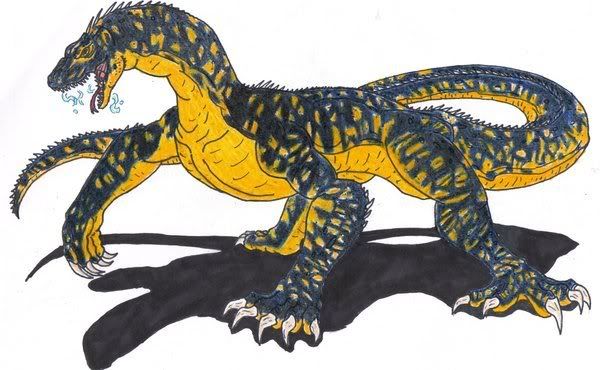
In this day and age, Australia is thought of as desert filled with eucalyptus trees and cotton plantations. The animals usually associated with this continent are koalas, kangaroo, wombats, and crocodiles, some of the largest to be found. There used to be other animals, commonly referred to as megafauna, that roamed this continent before being wiped out by plague or man. These were nightmarish versions of the creatures that we have today. Australia once held 10-foot tall kangaroos that fed on flesh rather than vegetation, and at one time had monitor lizards that dwarfed the Komodo dragon. This was megalania prisca, a reptile reaching 30 feet in length and weighing at least 1,000 pounds or more. The Komodo dragon is roughly the size of a lion, but megalania was bigger than an average dairy cow. Extinct megalania is listed with the many casualties of the Ice Age. Or is it extinct? The creature has been sighted many times in the last century, and some sightings suggest that it lives also in New Guinea. During the middle of the day, a surveyor returned to his truck. Tired, he wanted nothing more than to go home. He spied what he thought was a fallen tree near his car. Blaming his fatigue for his lack of details he climbed in his car and slammed the door. The "log" suddenly bolted away! It ended up being a lizard of 15 feet in length. Australian cryptozoologist Rex Gilroy is convinced these creatures are still alive and it is only a matter of time before one is captured or killed and brought in. As recently as the late '70s there have been megalania sightings. In July 1979, Rex Gilroy was informed of footprints of the creature found in a recently plowed field. Across the field were 30 or so tracks from what looked like an enormous lizard. Rain had ruined most of the tracks but Gilroy was able to make a plaster cast of one that had been preserved. The footprint looked surprisingly like something that might have been made by a Megalania. Also in 1979 a sighting of megalania arose, this time by the best possible witness. Herpetologist Frank Gordon, after conducting some field work in the Wattagan Mountains in New South Wales, returned to his vehicle. After starting his engine he saw, what he at first thought was a log, scampering off. It ended up being a lizard of some 30 feet or more in length. Another incident includes a farmer who observed a gigantic lizard walking along one of his fields. It walked along a wire fence, so the farmer used a set of fence posts as a guide. His estimate of the beast was a length of twenty to twenty-five feet. The size corresponds with megalania. Megalania might not be constrained only to Australia--some sightings suggest it may live in New Guinea. A French priest in the 1960's was traveling up river with a native guide in order to reach his mission. During the trip he spotted a large lizard lying on a fallen tree in the sun. He told the native to stop, but being badly frightened, the native continued the journey. The priest returned to the spot the following morning and measured the tree. It was 40 feet long, yet the lizard almost matched it. Whether or not megalania is still alive today is uncertain, but until a dead body, or perhaps a living one, is brought in we will forever find it in textbooks as an extinct animal of prehistoric times. |
|
|
|
|
|
Edited by
tazzops
on
Wed 08/17/11 05:56 AM
|
|
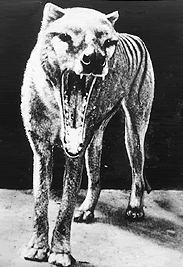
HISTORY The Tasmanian Tiger, otherwise known as the Thylacine (a conjugation of its scientific name) was an inhabitant of Australia and Tasmania up to about 12,000 years ago. Once dingoes appeared on the Australian mainland the thylacine population disappeared, with the only surviving population being left on the island of Tasmania. When farmers moved to Tasmania in the early 1800s, the thylacines were seen as pests that were good for nothing other than killing the livestock of the farmers. A systematic slaughter of the thylacines was set in place, with bounties being rewarded for the scalps. By the early 1900s thylacines were rare creatures, and the last bounty was paid in 1909. The last reported killing of a "tiger" was 1930. The thylacines were given protected status in 1933, but it was too late... the last thylacine found was captured and sent to the Hobart Domain Zoo just two months after they became a protected species. This last thylacine died on September 7, 1936. The people of Australia and Tasmania mourned the loss of their Tasmanian Tiger. Tasmania put the thylacine on its official Coat of Arms. This thylacine was later named "Benjamin". DESCRIPTION The thylacine closely resembles a dog, but it is actually a carnivorous marsupial, belonging to the same family as the kangaroo and tasmanian devil. The male thylacine would reach 6 feet in length from head to tail, at about 45 lbs. It sported distinctive stripes that began in mid-back and continued down to the tail. Females were smaller. The bunched and extended rear was reminiscent of hyenas. The tail was long, thin, inflexible and did not wag. Its fur was coarse and sandy-brown. They had pouches in which they carried their young. The opening on their pouches faced towards the rear of the animal, rather than towards the head (as with Kangaroos). Thylacines often hunted in pairs, but they did not have great speed, the best they could do was a fast clumsy "ambling", and they seemed to catch up to prey mainly by exhausting it from constant chase. They fed on various animals up to the size of kangaroos. They had powerful elongated jaws with a huge gape that could crush the skulls of their victims. When hunted by people using dogs, the thylacines would show no fear when cornered and would often kill the first dog to go in. The thylacines normally did not make any sound, but while hunting they were heard to sometimes make a quick barking "yip-yip". No known recording exists. Thylacines were primarily nocturnal animals. Little is known about their social habits. From shot and captured specimens it seems that a typical thylacine litter was 3 or 4 "pups". The thylacines that were captured and put into captivity often died quickly, but some survived up to 13 years. They did not make for great attractions at the zoos, caged thylacines were morose and did not respond to affection from their human caretakers. THE SIGHTINGS BEGIN Soon after Benjamin's death, reports of thylacine sightings came in from the mountains of northwestern Tasmania. Australia's Animals and Birds Protection Board sent an investigative team into the area but all they came back with were some interesting reports from the inhabitants of the area. Interest was high and another expedition that was sent in 1938 found the first evidence of living thylacines - footprints that were positively identified as belonging to thylacines. After this expedition, World War II intervened and the next expedition did not take place until 1945. This privately funded expedition found thylacine footprints and collected more sighting reports. SHEEP KILLINGS In 1957 zoologist Eric R. Guiler, chairman of the Animals and Birds Protection Board, went to Broadmarsh to investigate the killing of some sheep by an unknown predator. Tracks were found that were identified as thylacine prints. But no thylacine was found. Several more expeditions followed between 1957 and 1966, but these produced only more footprints and more reports of sightings from the local residents. HIDDEN CAMERAS In 1968 a Tiger Center was established, to which people could report their thylacine sightings. Expeditions continued to beat the brush in the wildlands of Tasmania searching for thylacines. In the 1970s a project was set up by the World Wildlife Fund that set up several automatic-camera units at locations where sightings were concentrated. Bait was used and infrared beams were used to trigger the cameras. The project ended in failure in 1980, no thylacines were captured on film. In his official report, project leader Steven J. Smith of the National Parks and Wildlife Service (NPWS) stated his view that thylacines are extinct. Zoologist Eric Guiler later set up his own hidden camera operation, but this attempt to capture a living thylacine on film also failed. But the number of reported sightings shot up between 1970 and 1980, a total of 104. This gave investigators new hope in finding a remnant population of thylacines still surviving in the more remote areas of Tasmania. Reports of living thylacines also began to come in from southwestern Western Australia, which was very strange because thylacines were eliminated from mainland Australia thousands of years ago after the introduction of dingoes, which made quick work of the slower moving thylacines. LIVING THYLACINE IDENTIFIED BY PARK RANGER On a rainy night in March of 1982 a NPWS park ranger was sleeping in the back seat of his car. Something woke him up and he turned on his spotlight, and turned it onto an animal that was about 20 feet away. He said it was a thylacine, "an adult male in excellent condition, with 12 black stripes on a sandy coat." The animal ran off, and because of the rain, no footprints were left. The NPWS kept the report from the public until January 1984, in order to keep people from going to the area and disturbing the possible habitat of the last living thylacines. This sighting did not prove the existence of living thylacines to the government's satisfaction though, and no official statement was made to that effect. There was also the question of was to do about the extensive mining and timber operations in the area. If living thylacines were found, would the government have to shut down those commercial enterprises? The question of protection of thylacines versus business interests was a thorny one that the government would have to be very careful about. Real proof of living thylacines was necessary - a live or dead thylacine body would have to be produced. A THYLACINE SHOT IN 1981? Following the rash of thylacine sightings in Western Australia, the state's Agricultural Protection Board sent Kevin Cameron, a tracker of aboriginal descent, to investigate. Soon Cameron reported that he himself sighted and identified a living thylacine in Western Australia. But this was not proof enough. Then in 1985 Cameron produced pictures that he claimed were taken of a living thylacine, along with casts of thylacine footprints. The pictures were presented to zoologist Athol M. Douglas at the Western Australian Museum in Perth. They showed an dog like animal burrowing at the base of the tree. The head was hidden from view, but its striped back and stiff tail strongly implied that it was a thylacine. Suspicions began to arise though. Cameron would not say where he took the pictures, and he vacillated on giving permission to have the pictures reproduced for publication, eventually agreeing. Cameron accompanied Douglas to a photographic laboratory while he made enlargements. Douglas found, "When I saw the negatives, I realized Cameron's account with regard to the photographs was inaccurate. The film had been cut, frames were missing, and the photos were taken from different angles - making it impossible for the series to have been taken in 20 or 30 seconds, as Cameron had stated. Furthermore, in one negative, there was the shadow of another person pointing what could be an over-under 12 gauge shotgun. Cameron had told me he had been alone. It would have been practically impossible for an animal as alert as a thylacine to remain stationary for so long while human activity was going on in its vicinity. In addition, it is significant that the animal's head does not appear in any of the photographs." The story and pictures were released in the New Scientist magazine, and its readers were soon criticizing the authenticity of the photographs. They pointed out that the animal seemed to stay dead still from photograph to photograph. And they realized by the differing lengths of the shadows that the pictures were taken over at least an hour. It would seem that the pictures were a hoax, and the specimen was a stuffed thylacine. But the first picture, the one that showed the shadow of a person holding a gun aimed at the thylacine, was omitted from the New Scientist story. Douglas feels that, "The full frame of this negative is the one which shows the shadow of the man with a rigid gun-like object pointing in the direction of the thylacine at the base of the tree. This shadow was deliberately excluded in the photos published in New Scientist. If I am correct in this supposition, the thylacine was alive when the first photo was taken, but had been dead [and frozen in rigor mortis] for several hours by the time the second photograph was taken." Douglas hoped that the carcass would surface, but that is doubtful since shooting a thylacine is punishable by a $5000 fine. Cameron was not helpful in shedding any further light on it. So the "Cameron" episode remains clouded in mystery. Either it was a hoax using a stuffed thylacine, or a living thylacine was shot, for reasons unknown, and pictures were taken of it. The fact that the head is not in any of the photographs may be because the animal was shot in the head. If they were using a stuffed thylacine, then why hide the head? THYLACINE CARCASS FOUND IN WESTERN AUSTRALIA In 1966 an expedition from the Western Australia Museum found a thylacine carcass in a cave near Mundrabilla Station. Carbon dating showed the carcass to be 4,500 years old, but that method of dating may be invalid since the body had been soaking in groundwater which permeated the whole body. Zoologist Athol Douglas reported that along with the thylacine carcass was also found a dingo carcass, and that the dingo carcass was much more deteriorated than the thylacine carcass. Douglas gave his opinion that the dingo carcass was not older than 20 years, and that the thylacine carcass was not older than a year. But since the carbon dating argues against a recent death of this thylacine, official proof of surviving thylacines has still not been claimed. THE SIGHTINGS SPREAD Cryptozoological investigator Rex Gilroy has collected various reports of thylacine sightings from "over a wide area of the rugged eastern Australian mountain ranges, from far north Queensland through New South Wales to eastern Victoria." Casts of footprints found in those areas have been verified as thylacine prints. Gilroy even claims to have seen a thylacine himself. Diving at night with a friend along a highway towards the Blue Mountains west of Sydney, something dashed out of the scrub along the highway and ran in front of them. It then stopped and stared back at the headlights for a few seconds before running off into the scrub, towards Grose Valley. It was "almost the size of a full-grown Alsatian dog, with fawn-colored fur and a row of blackish stripes...I have no doubt that it was a thylacine; its appearance matched that of stuffed specimens preserved in Government museums." Another Park Ranger reported seeing a thylacine in 1990. Ranger Peter Simon was in the Namadgi-Kosciusco National Park along the New South Wales-Victoria border when he saw what he identified as a thylacine in broad daylight at a range of 100 feet. After Peter Simon published an article on his sighting and the thylacine mystery in The Age magazine, he received many cards and letters from Victoria residents who also claimed to have seen Thylacines. Peter Simon said that the reports were so consistent that they, " left me in no doubt that each had seen something unusual [and] ... broadly consistent with the appearance of a thylacine." SUPERNATURAL APPEARANCES? In 1982 a Western Australian farming couple claimed to have lost livestock to thylacine predation, and say that they always gets a "prickly feeling" at the back of his neck when the thylacines were nearby. That "prickly feeling" is sensation that is widely reported when people experience encounters with strange out of place creatures or entities. Australian writer Tony Healy reported that on the day before Ranger Peter Simon was to have his encounter with a thylacine, his hunting dogs refused to leave a truck that they were being transported in after they heard strange harsh panting sounds in the brush nearby. At a Benedictine monastery named New Hoacia, the secretary to the Addot, Tony James, walked into a room early in the morning and saw a thylacine, "We both froze, and he looked at me, in quite a fearless way, and I sense that he was just simply filled with curiosity at the sighting." The animal fled. Tony feels that perhaps the animal was feeding off the table scraps that were usually left out for the magpies every morning. Another member of the monastery also reported seeing an animal that fit the description of a thylacine while driving from the monastery. On April 7, 1974, at 3:30 a.m. Joan Gilbert was driving in the outskirts of Bournemouth, England, when a strange animal ran across her headlights. It was a, "strange striped creature, half cat and half dog. It was the most peculiar animal I have ever seen. It had stripes, a long thin tail, and seemed to be all gray, though it might have had some yellow in it. Its ears were set back like a member of the cat family, and it was as big as a medium-sized dog. It was thin, and it definitely was not a fox." She identified it as a thylacine when she found a picture of it in a reference book. |
|
|
|
|
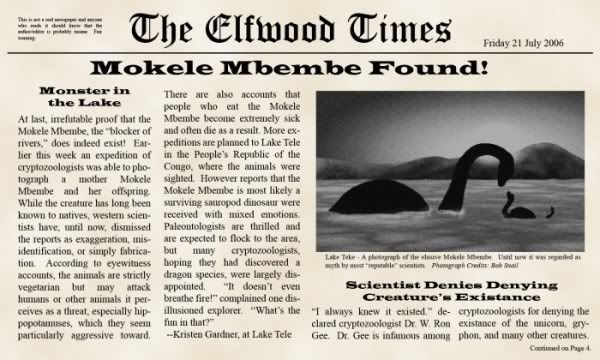
|
|
|
|
|

|
|
|
|
|
|
Edited by
tazzops
on
Wed 08/17/11 06:25 AM
|
|

DINGONEK A walrus-like creature in the heart of Africa? Such is the description of the dingonek by John Alfred Jordan, an explorer who actually shot at this unidentified monster in the River Maggori in Kenya in 1907. Jordan claimed this scale-covered creature was a big as 18 feet long and had reptilian claws, a spotted back, long tail, and a big head out of which grew large, curved, walrus-like tusks. Natives of the area further described it as having a scorpion-like tail and reported that it would kill any hippos, crocodiles, or human fisherman that dared encroach on its territory. This sounds like a fantasy creature, but consider this: At the Brackfontein Ridge in South Africa is a cave painting of an unknown creature that fits the description of the dingonek, right down to its walrus-like tusks. |
|
|
|
|
|
Edited by
tazzops
on
Wed 08/17/11 06:52 AM
|
|
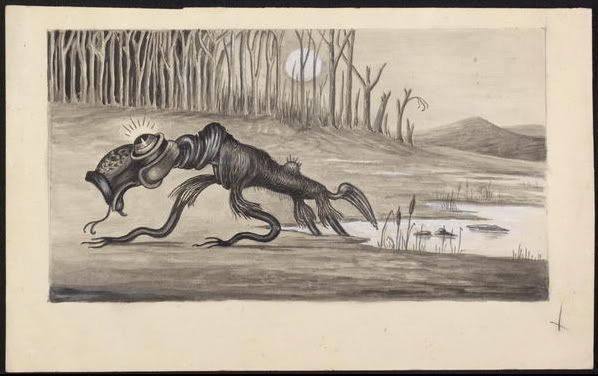
For those who grew up in Australasia (primarily Australia and NZ), the bunyip will be familiar. The bunyip is a large mythical creature from Australian Aboriginal mythology, said to lurk in swamps, billabongs, creeks, riverbeds and waterholes. It has been described as a giant starfish that walks on land. Other common descriptions from 19th century newspaper accounts include a dog-like face, dark fur, a horse-like tail, flippers and walrus-like tusks or horns or a duck like bill. The very first use of the word to describe this Australian cryptid appeared in a newspaper in 1845: “The Bunyip, then, is represented as uniting the characteristics of a bird and of an alligator. It has a head resembling an emu, with a long bill, at the extremity of which is a transverse projection on each side, with serrated edges like the bone of the stingray. Its body and legs partake of the nature of the alligator. The hind legs are remarkably thick and strong, and the fore legs are much longer, but still of great strength. The extremities are furnished with long claws, but the blacks say its usual method of killing its prey is by hugging it to death. When in the water it swims like a frog, and when on shore it walks on its hind legs with its head erect, in which position it measures twelve or thirteen feet in height.” |
|
|
|
|
           
|
|
|
|
|
|
Found some others, will post later. They are scary indeed Honey Bunny Christine.
      
|
|
|
|
|
|
Scary yes, especially that big hairy white snow monster, looking forward, to your posts
          
|
|
|
|
|
|
Edited by
tazzops
on
Wed 08/17/11 04:49 PM
|
|

Mister Ed is an American television situation comedy produced by Filmways[1] that first aired in syndication from January 5 to July 2, 1961, and then on CBS from October 1, 1961, to February 6, 1966. The stars of the show are Mister Ed, a palomino horse who could talk ("played" by gelding Bamboo Harvester and voiced by Allan Lane), and his owner, an eccentric and enormously klutzy yet friendly architect named Wilbur Post (portrayed by Alan Young). Much of the program's humor stemmed from the fact Mister Ed would speak only to Wilbur, as well as Ed's notoriety as a troublemaker. According to the show's producer, Arthur Lubin, Young was chosen as the lead character because he "just seemed like the sort of guy a horse would talk to".[2] Lubin, a friend of Mae West, scored a coup by persuading the screen icon to guest star in one episode. In the United States, reruns aired on Nick at Nite from March 3, 1986, to February 1, 1993.[3] Sister station TV Land also reran the show from 1996-98 and again from 2003-06. The series is currently broadcast every morning on This TV, along with sister series The Patty Duke Show. As of January 1, 2011, the first two seasons of the show are available on Hulu.[4] |
|
|
|
|
|
I love Mister Ed, a horse is a horse of course of course, don't know what the rest of the lyrics are, did you know how they got the horse to make the movement with his mouth like that, they made him eat peanut butter.
|
|
|
|
|
|
Edited by
tazzops
on
Wed 08/17/11 04:57 PM
|
|
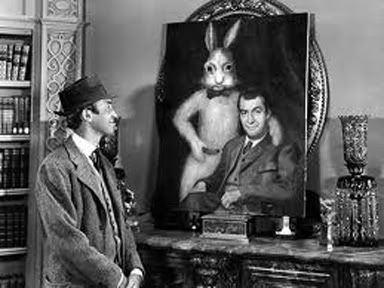
Elwood P. Dowd (Stewart) is a middle-aged, amiable (and somewhat eccentric) individual whose best friend is an invisible 6'3.5" tall rabbit named Harvey. As described by Dowd, Harvey is a pooka, a benign but mischievous creature from Celtic mythology who is especially fond of social outcasts (like Elwood). Elwood has driven his sister and niece (who live with him and crave normality and a place in 'society') to distraction by introducing everyone he meets to his friend, Harvey. His family seems to be unsure whether Dowd's obsession with Harvey is a product of his (admitted) propensity to drink or perhaps mental illness. Veta (Josephine Hull) and Myrtle Mae (Victoria Horne) His sister, Veta Louise Simmons (Hull), tries to have Elwood committed to a sanatorium. In exasperation, she admits to the attending psychiatrist (Dr. Lyman Sanderson, played by Charles Drake) that, after so many years of putting up with the invisible rabbit, she sees Harvey every once in a while. This causes Dr. Sanderson to let Elwood out and lock Veta up. After sorting out the mistake, Dr. Chumley, head of the sanatorium (Cecil Kellaway) decides that to save the reputation of the sanatorium he must bring Elwood back. At one point, when her daughter asks how someone possibly could imagine a rabbit, Veta says to her "Myrtle Mae, you have a lot to learn and I hope you never learn it". Years ago my mother used to say to me, she'd say, "In this world, Elwood, you must be" -- she always called me Elwood -- "In this world, Elwood, you must be oh so smart or oh so pleasant." Well, for years I was smart. I recommend pleasant. You may quote me. James Stewart as Elwood P. Dowd, Elwood P. Dowd's 'Philosophy' of Life When tracked down, Elwood goes through several ordeals, although he remains largely oblivious to the plans put in place for him by Dr. Chumley, Judge Gaffney (William Lynn) and Veta Louise. In a poignant scene where Dr. Sanderson and his nurse Miss Kelly (Peggy Dow) follow Elwood into an alley at the back of his and Harvey's favourite bar - Charlie's, Elwood tells the incredible story of how he came to meet Harvey, and explains the way in which people react when they meet them. In a later scene, he gives Dr. Chumley an insight into his 'philosophy' of life.' In the final scene of the film, Elwood (along with everybody else) arrives back at the hospital. By this point, Dr. Chumley is not only convinced of Harvey's existence, but has begun hanging out with him on his own, with a mixture of admiration and fear. Dr. Sanderson convinces Elwood to come into his office where he'll receive a serum that will stop Dowd from "seeing the rabbit". As they are preparing for the injection, Elwood's sister is told by their cab driver about all the other people he has driven to the sanatorium to receive the same medicine, warning her that Elwood will become "just a normal human being. And you know what stinkers they are." Upset by the very thought of this, Veta halts the procedure by banging on the examining room door, at which point Elwood comforts her and explains her tears to others with, "Veta's all tired out, she's done a lot today". Miss Kelly (Peggy Dow) and Dowd (James Stewart). Judge Gaffney (William H. Lynn) is in the background. At the tale's end Harvey is given the choice of remaining with Dr. Chumley (and spending two weeks with him in Akron, Ohio) or continuing his life with Elwood. The rabbit catches up with Elwood at the exit to the sanatorium, the gate is seen opening as Harvey follows the others out (Harvey's existence is confirmed earlier in the film when a character looks up Pooka in a dictionary and finds he is addressed by name in the definition). |
|
|
|
|
|
I love Mister Ed, a horse is a horse of course of course, don't know what the rest of the lyrics are, did you know how they got the horse to make the movement with his mouth like that, they made him eat peanut butter. Hello, I'm Mister Ed A horse is a horse, of course of course, and no one can talk to a horse of course, that is of course, unless the horse, Is the famous Mister Ed! Go right to the source and ask the horse. He'll give you the answer that you'll endorse. He's always on a steady course. Talk to Mister Ed. People yak-it-ti-yak a streak and waste your time of day, but Mister Ed will never speak, unless he has something to say... A horse is a horse, of course of course, And this one will talk 'til his voice is hoarse. You never heard of a talking horse? Well, listen to this... I am Mister Ed |
|
|
|
|
   Mister Ed Mister Ed   
|
|
|
|
|
|
I had it on my computer. I knew someone would indeed ask.
              
|
|
|
|
|
|
Edited by
tazzops
on
Thu 08/18/11 08:44 AM
|
|
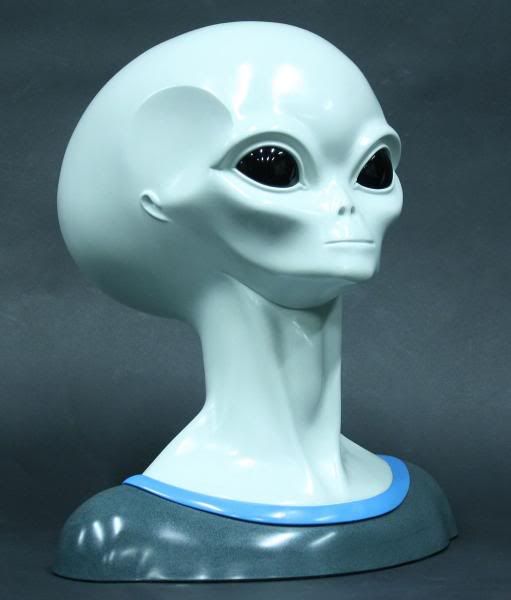



Origin The Greys evolved naturally from a cetacean-like life form on another world or were artificially modified though genetic engineering by an outside species or themselves. They have evolved beyond the sexual reproduction process so that all sexual organs and their digestive tracts have totally atrophied. They are no longer capable of eating or indulging in sexual activities. Because of these manipulations, cloning, became their only form of reproduction. A simple explanation for the origins of the Greys would be and evolutionary process similar to that of humans, but from a cetacean ancestor as opposed to a primate ancestor. At one point, instead of returning to the oceans, or perhaps leaving the oceans, cetacean simply evolved as a land-dweller, while retaining the vestigial features of the fish. Some time later, the Greys either had a large accident or other event that severely degenerated its genetic pool, or decided that the random genetic mixing of sexual reproduction was inadequate for their society, and embarked on cloning as a means to overcome their problem. After a period of time, the knowledge of advanced genetics, as well as the technology needed to created more advanced versions of their genetic machines were somehow lost, and the result is a society that depends on its machines for speciessurvival, but who cannot recreate the technology. Another of the theories possible begins with a cetacean life form evolved on another planet. Unlike Terran cetaceans, they did not return to the oceans, but were discovered and later altered and cloned by another species. This species (called the Masters), needed a source of slave labor, and thus searched for an intelligent lesser species that they could genetically manipulate in order to be used effectively. Arbitrarily assuming that this period of time was about one million years ago, the most evolved species at that time on Terra would have been dolphins and whales. This might also have been possible on another planet, where a similar species evolved instead of a primate-like organism. Under this theory, the cetacean ancestors of the Greys were taken and genetically altered into an upright, bipedal species capable of doing labor for the Masters. After a time, however, the Greys apparently rebelled, and are now on their own, using the technology of the Masters, but since they were created to simply operate them, and not to design them, their knowledge of the technology's operation is lacking.This theory would explain the lack of knowledge of genetics that the Greys seem to suffer from, and why they can't simply make their own genetic code artificially more diverse. They are able to manipulate the technology, and use it to their advantage, but are unable to understand the actual theoretical aspects and operations behind the use of their equipment, thus resulting in a need for abduction of humans. Biology Various descriptions taken from dissections and abductees’ reports relate the following characteristics: a non-functioning digestive system; absence of reproduction organs; two separate brains; movement is deliberate, slow and precise; alien subsistence requires that they must have human blood and other biological substances to survive. The two separate brains are separated by mid-cranial lateral bone without any apparent connection. Some autopsies have revealed a crystalline network which is thought to have a function in telepathic which help to maintain the group-consciousness between members of the same species. Even without sexual organs, the Greys seem to have gender, and are not simply neuter. The genders, however, appear to be completely determined by the mind, with the bodies being identical almost identical. Abductees report that some Greys 'feel' or 'seem' feminine, while others are very masculine. This seems to point to a time of sex differentiation, which was bred out physically, leaving only the mental pattern to demonstrate the differences between males and females in the Grey social infrastructure. It should also be noted that female Greys are very rarely seen, and are reported to be sterile and incapable of giving birth to offspring. The males are the ones most commonly observed, and simple deduction will show that there is one scenario possible: the Grey females are few in number, and must be isolated for some reason, perhaps to prevent their loss or for genetic repositories. Nevertheless, because Greys cannot breed naturally, due to a lack of sexual organs, artificial methods must be incorporated into their society on a massive, if not simply large, scale to prevent their demise as a species. The Greys consume nourishment through a process of absorption through their skin. The process, according to abductees who have witnessed it, involved spreading a biological 'liquid protein' formula that has been mixed with hydrogen peroxide [which oxygenates the slurry and eliminates bacteria] onto their skin. Food is converted to energy by chlorophyll by a photosynthetic process. To eliminate, they need to pass the substance through some part of their body, much the same way plants eliminate through their skin or outer shells. They use hydrogen peroxide for helping with that elimination as well. Waste products are then excreted back through the skin. Many abductees have noted that the Greys have a distinct series of odors. The Zeta Reticuli Greys feed upon glandular secretions of humans and are said to abduct humans and extracting the secretions for themselves.It is also said that Greys absorb certain substances from parts of the cattle that stabilize them during the cloning process, mostly substances that comes from certain mucus membranes: the lips, nose, genitals and rectum, and also from certain organs. Aside from feeding off of human and animal proteins and fluids, they also allegedly feed off the 'life energy', the 'vital essence' or 'soul energy' of humans as do other reptilian species in what may be considered a vampirial type of hunger for human vital fluids. 
Description The most widely reported type of alien is a small grey being approximately 1.0m-1.25m in height, with large oval black eyes and skin colors ranging from gray-white to grey-brown to gray-green to grey-blue. Erect standing biped, small thin build, large and rounded rear skull area, head larger than humans with inverted triangular shape, absence of auditory lobes and nose, absence of body hair, large oval tear-shaped eyes which are opaque black with vertical slit pupils, arms resembling praying mantis which reach to the knees, long hands with small palm, claw-like fingers (two, three or four fingers), tough gray skin which is reptilian in texture, small feet with four small claw-like toes, no genitalia visible |
|
|
|
|
      Aliens and sex problems on the next Jerry Springer Show Aliens and sex problems on the next Jerry Springer Show
|
|
|
|
|
|
I think that show has been already been done.
  
|
|
|
|
|







